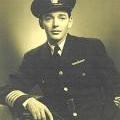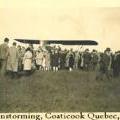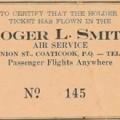 Born on December 12, 1912 in Coaticook, third child of Stewart Curtis and Mary Wellman (Lovell) Smith, a fifth generation Canadian and descendent of the prominent Lovell family, respected for its diverse business activities, and its many years in Federal, Provincial and local politics representing Stanstead County. Roger Lovewell Smith’s fascination with flying began when he saw a photograph of an airplane in an article on Charles Lindbergh. In 1928, at age 15, he convinced WWI aviator and airmail pioneer Hervé St. Martin of the Continental Aero Corporation to hire him, working as a mechanic and test pilot in exchange for flying lessons. At age 16 he performed his first solo flight in an OX-5 Travel Air E-2000 bi-plane.
Born on December 12, 1912 in Coaticook, third child of Stewart Curtis and Mary Wellman (Lovell) Smith, a fifth generation Canadian and descendent of the prominent Lovell family, respected for its diverse business activities, and its many years in Federal, Provincial and local politics representing Stanstead County. Roger Lovewell Smith’s fascination with flying began when he saw a photograph of an airplane in an article on Charles Lindbergh. In 1928, at age 15, he convinced WWI aviator and airmail pioneer Hervé St. Martin of the Continental Aero Corporation to hire him, working as a mechanic and test pilot in exchange for flying lessons. At age 16 he performed his first solo flight in an OX-5 Travel Air E-2000 bi-plane.
In 1932, Smith became Canada’s youngest licensed commercial pilot, at age 19. With a small Travel Air E-4000 bi-plane, he started the Roger L. Smith Air Service, barnstorming across the country, giving rides in his flying machine for $2 at events like the Ayer’s Cliff Fair.
Smith obtained his Air Engineer’s Certificate at age 22. After completely restoring a four-passenger Curtiss Robin monoplane that had been badly damaged in a fire, he began flying as a bush pilot for the McKay Exploration Company and St. Martin Air Transport. He later worked with Hartland Molson at Dominion Skyways Ltd., the first regular carrier to use two-way radio communication in Canada.
From 1935 to 1939, Smith faced harsh environmental conditions as he transported surveyors, engineers, prospectors, developers and their supplies to areas in Quebec and Ontario that could only be accessed by plane. Smith used his flying expertise and explorer spirit to open remote northern regions for industry and development, setting the stage for economic expansion that catapulted Canada into a leading industrialized nation by the middle of the 20th century.
 In 1936, Smith added a Waco Cabin bi-plane to his fleet. In 1939, his skills and dedication caught the attention of Trans-Canada Air Lines (TCA, now Air Canada), which recruited him. As first officer he made the first round trip flight from Toronto to Moncton, and was promoted to Captain after only nine months. On a historic flight a year later, he made the company truly trans-Canadian by flying the final segment of the Pacific to Atlantic trip (Moncton-Halifax) in a Lockheed 14 Electra. Thus Smith helped fulfil C. D. Howe’s dream of connecting Canadians coast to coast through the new version of the railroad – aviation.
In 1936, Smith added a Waco Cabin bi-plane to his fleet. In 1939, his skills and dedication caught the attention of Trans-Canada Air Lines (TCA, now Air Canada), which recruited him. As first officer he made the first round trip flight from Toronto to Moncton, and was promoted to Captain after only nine months. On a historic flight a year later, he made the company truly trans-Canadian by flying the final segment of the Pacific to Atlantic trip (Moncton-Halifax) in a Lockheed 14 Electra. Thus Smith helped fulfil C. D. Howe’s dream of connecting Canadians coast to coast through the new version of the railroad – aviation.
Smith joined the war effort, training Royal Canadian Air Force and later, U. S. Army Air Force, pilots on Lockheed 10 and 14 aircraft. As a senior pilot he was seconded to the Canadian Government Trans-Atlantic Air Service in 1943, and in 1944 Smith began flying the AVRO Lancastrian. A year later he began flying to and from the United Kingdom, risking his life to ensure secret cargo and equipment, military and government personnel reached their destination safely in the midst of the Battle of the Atlantic.
After the war he returned to TCA and, in 1946, was selected to fly the first all-express trans-Atlantic cargo load in Canadian commercial aviation history. By 1947, he was flying Canadair North Stars instead of Lancastrians, and while at TCA flew many different types of aircraft, such as the Super Constellation and the DC-8 on domestic and international routes.
After Joey Smallwood travelled to London, England in 1949 to officially sign Newfoundland and Labrador into the Dominion of Canada, Smith escorted the newest provincial premier back home.
Smith set a world trans-Atlantic speed record in 1961, flying 5874 kilometres (3650 miles) from Winnipeg to Prestwick, Scotland, in 6:54 – almost one hour faster than ever before. By the time he retired in 1971 he had accumulated 24,000 flying hours, more than 1000 trans-Atlantic crossings, and had an impeccable record.
 His passion for aviation continued. Smith owned, restored and flew several airplanes, including a Cessna 140, Piper Cub, Republic Seabee Amphibious and Stearman PT-17. By the time he gave up the controls in 1999 at age 86, he had exceeded 27,000 flying hours and had flown more than 50 different types of aircraft, almost entirely as pilot-in-command.
His passion for aviation continued. Smith owned, restored and flew several airplanes, including a Cessna 140, Piper Cub, Republic Seabee Amphibious and Stearman PT-17. By the time he gave up the controls in 1999 at age 86, he had exceeded 27,000 flying hours and had flown more than 50 different types of aircraft, almost entirely as pilot-in-command.
Captain Roger Lovewell Smith died on August 3, 2003, at the age of 90. He had flown for 70 of the 100 years powered flight had been possible. This first-generation aviator started with single-engine, open cockpit prop planes without radio, weather forecasts and other navigational aids common today, and ended with multi-engine high-speed jets carrying hundreds of people. His dedication to aviation never faltered, despite the harsh conditions of remote northern areas, the dangerous climate of WWII over the Northern Atlantic, and the vast number of flights he piloted without incident.
In 2003, Roger L. Smith was posthumously inducted into the Quebec Air and Space Hall of Fame. As then Prime Minister Jean Chrétien noted, he “left an indelible mark on the history of aviation.”
All photographs courtesy of the author.
*The author is one of three sons born to Roger and Catherine Smith.